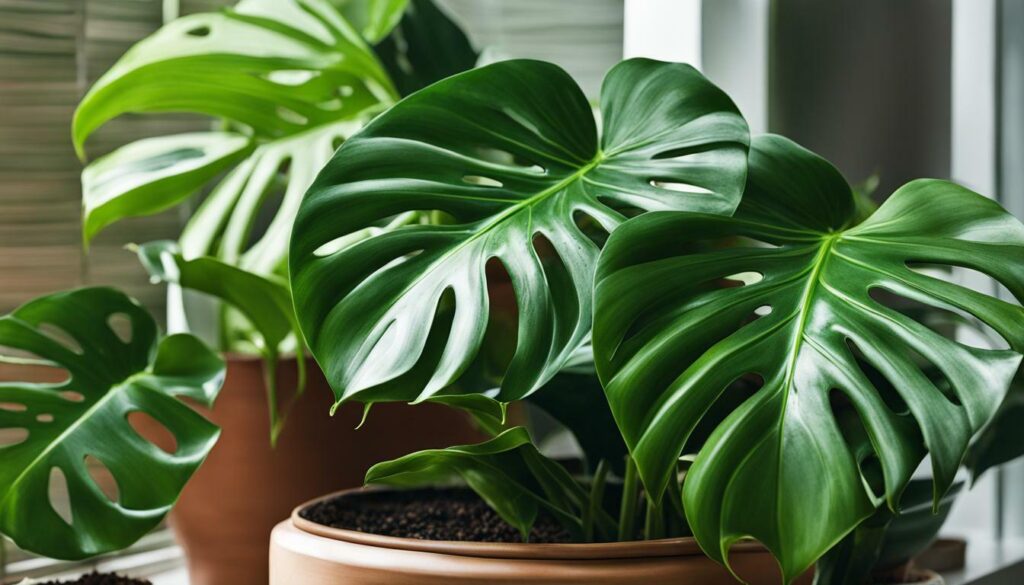If you’re a proud owner of Monstera Borsigiana, or are considering bringing one home, it’s important to understand how to properly care for this rustic tropical plant.
Monstera Borsigiana is a variety of monstera plant that is slightly smaller than Monstera Deliciosa and grows faster. It can be identified by the lack of ruffles or bumps on the stem where it meets the base of the leaf. Monstera Borsigiana is also known for its ability to mutate and display variegation.
This stunning plant can be found in local nurseries, home improvement stores, and online. But once you bring it home, you’ll need to follow some essential care tips to ensure its health and growth.
Table of Contents
ToggleKey Takeaways:
- Monstera Borsigiana is a variety of monstera plant that is slightly smaller and grows faster than Monstera Deliciosa.
- It can be identified by the lack of ruffles or bumps on the stem where it meets the base of the leaf.
- Monstera Borsigiana can display variegation, making it a unique and attractive houseplant.
- You can find Monstera Borsigiana in local nurseries, home improvement stores, and online.
- Proper care for Monstera Borsigiana includes using well-draining soil, providing bright but indirect sunlight, regular watering, maintaining moderate temperature and humidity levels, fertilizing regularly, and practicing proper pruning and repotting techniques.
Identifying Monstera Borsigiana
Monstera Borsigiana, a slightly smaller variety of the monstera plant, can be identified by its lack of ruffles or bumps on the stem where it meets the base of the leaf. This distinguishing feature sets it apart from other monstera varieties, such as Monstera Deliciosa. The absence of these characteristic bumps gives Monstera Borsigiana a sleek and smooth appearance, making it an attractive choice for plant enthusiasts.
In addition to its unique stem structure, Monstera Borsigiana is also known for its ability to mutate and display variegation. Variegation occurs when the leaves develop unique patterns of color, often featuring shades of green, white, or cream. This adds to the visual appeal of the plant and makes it a sought-after variety among collectors.
If you’re looking to add a touch of elegance and uniqueness to your indoor garden, Monstera Borsigiana is a wonderful choice. With its smooth stem and potential for stunning variegation, it is sure to be a standout addition to any plant collection.
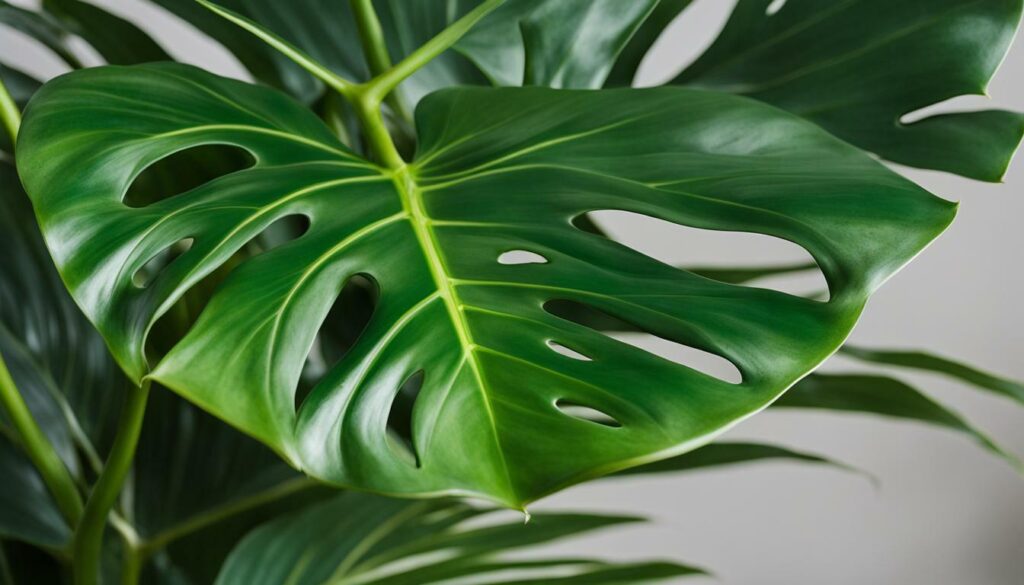
| Variety | Description |
|---|---|
| Monstera Deliciosa | A larger variety of monstera with heart-shaped leaves and distinct splits and holes. |
| Monstera Borsigiana Albo Variegata | A variegated form of Monstera Borsigiana, with leaves displaying beautiful white or cream patterns. |
| Monstera Borsigiana Aurea | A variety of Monstera Borsigiana with leaves that have a stunning golden hue. |
Where to Find Monstera Borsigiana
You can find Monstera Borsigiana for sale at various locations, including local nurseries, home improvement stores, and through online retailers. These plants have gained popularity among plant enthusiasts, and their availability has increased in recent years. Local nurseries often offer a wide selection of Monstera Borsigiana, allowing you to choose the specific variety or mutation that you prefer. They can provide valuable advice on caring for your new plant and help you select the best one for your home.
If you prefer the convenience of shopping from home, many home improvement stores now have online platforms where you can browse and order Monstera Borsigiana plants. These online retailers often offer a range of sizes, from small starter plants to larger, more mature specimens. They also provide detailed descriptions and photos, allowing you to make an informed decision before making your purchase.
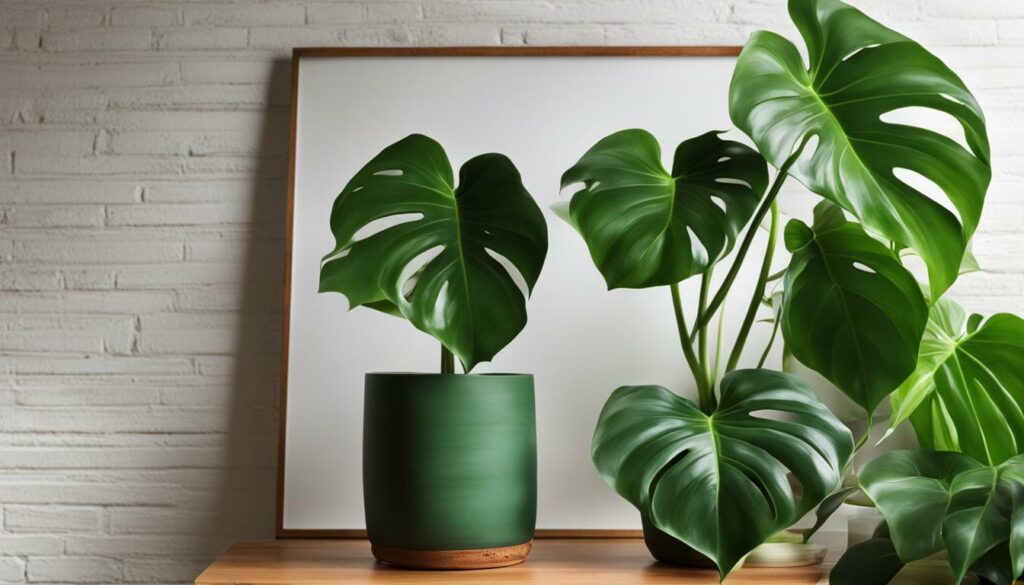
When searching for Monstera Borsigiana, be sure to check the prices at different locations to find the best deal. Prices can vary depending on factors such as plant size, rarity, and the seller’s pricing strategy. It’s also worth considering the shipping options and costs for online orders to ensure that your plant arrives in good condition. Whether you choose to buy from a local nursery or an online retailer, make sure to check the seller’s reputation and reviews before making your purchase. This will help ensure that you are getting a healthy plant from a reliable source.
| Location | Pros | Cons |
|---|---|---|
| Local Nurseries | – Wide selection – Expert advice – Ability to inspect the plant in person |
– Limited availability – Higher prices compared to some online retailers |
| Home Improvement Stores | – Convenience of online shopping – Variety of sizes available – Detailed descriptions and photos |
– Limited selection compared to nurseries – Shipping costs may apply |
| Online Retailers | – Extensive selection – Competitive prices – Convenient and accessible |
– Shipping may affect plant health – Unable to inspect the plant in person |
Regardless of where you choose to purchase your Monstera Borsigiana, it’s important to ensure that the seller provides proper packaging and shipping methods to protect the plant during transit. Your new Monstera Borsigiana will be a beautiful addition to your home or office, and with proper care, it will thrive and bring you joy for years to come.
Proper Soil and Watering Techniques
To ensure the health and growth of your Monstera Borsigiana, it’s crucial to use well-draining soil and water the plant appropriately. This tropical plant prefers soil that allows excess water to flow out easily, preventing root rot. A mixture of peat moss, perlite, and orchid bark is ideal for creating a well-draining medium.
When watering your Monstera Borsigiana, it’s important to strike a balance. Overwatering can lead to root rot, while underwatering can cause the leaves to wilt and dry out. The general rule of thumb is to water the plant when the top 2 inches of soil are dry. This will help prevent waterlogged roots while ensuring the plant receives enough hydration.
Another important aspect of proper watering is to avoid using cold water. Monstera Borsigiana prefers lukewarm water, as cold water can shock the plant’s roots and hinder its growth. Additionally, using filtered or distilled water can help prevent mineral build-up, which can be harmful to the plant.
| Soil | Watering |
|---|---|
| Well-draining mixture of peat moss, perlite, and orchid bark | Water when the top 2 inches of soil are dry |
“Proper soil and watering techniques are essential for the health and vitality of Monstera Borsigiana. By ensuring the soil is well-draining and watering appropriately, you can provide the ideal conditions for your plant to thrive.”
Propagation Methods
If you’re interested in expanding your Monstera Borsigiana collection or sharing the joy of this beautiful plant with others, propagation is a great option. There are two popular methods for propagating Monstera Borsigiana: stem cuttings and air layering.
- Stem Cuttings: To propagate through stem cuttings, select a healthy stem with at least one node. Cut the stem just below the node and place it in a glass of water or a well-draining potting mix. Keep the cutting in a warm and humid environment, maintaining moisture until new roots develop.
- Air Layering: Air layering involves creating a wound on the stem, applying rooting hormone, and wrapping that section with moist sphagnum moss or coco coir. This encourages the development of roots. Once roots have formed, you can cut below the air layer and pot the new plant.
Propagation can be a rewarding process, allowing you to create new plants from your existing Monstera Borsigiana. Remember to be patient and provide the proper care during the propagation journey.
Summary
Proper care for Monstera Borsigiana begins with using well-draining soil to prevent root rot. Water the plant when the top 2 inches of soil are dry, using lukewarm water to avoid shocking the roots. Be mindful of the temperature and humidity levels to ensure optimal growth. Additionally, mastering propagation methods like stem cuttings and air layering can help you expand your Monstera Borsigiana collection. By following these techniques, you’ll create a thriving and beautiful indoor oasis.
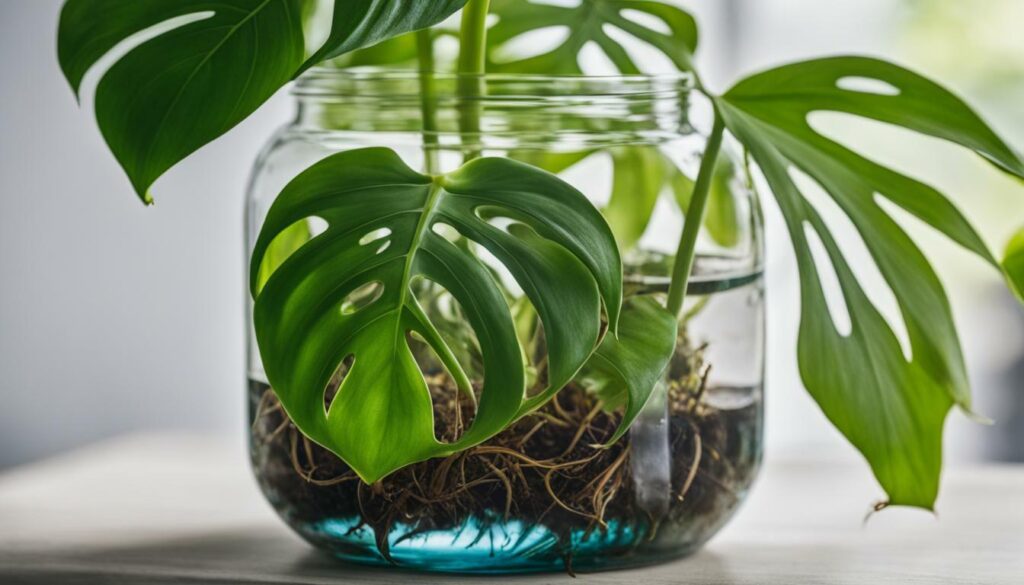
Monstera Borsigiana thrives in bright but indirect sunlight, so it’s important to position it in a location that receives ample light without direct exposure. Placing it near a north or east-facing window is ideal, as these directions provide the right balance of light intensity. Avoid placing it in direct sunlight, as this can scorch the leaves and cause damage to the plant.
When it comes to temperature, Monstera Borsigiana prefers a moderate climate. It can tolerate temperatures between 60°F (15°C) and 75°F (24°C). However, it’s important to protect it from extreme fluctuations in temperature, as this can stress the plant. Avoid placing it near drafts or vents that could expose it to cold or hot air currents.
Creating a stable environment for your Monstera Borsigiana is essential for its overall health and growth. Consider using a humidity tray or placing the plant near a humidifier to maintain optimal humidity levels. Additionally, misting the leaves occasionally can help mimic its natural tropical habitat and promote healthy growth.
Light and Temperature Cheat Sheet
| Light | Temperature |
|---|---|
| Bright but indirect sunlight | 60°F (15°C) to 75°F (24°C) |
| Avoid direct sunlight | Avoid extreme temperature fluctuations |
| North or east-facing window | Avoid drafts and vents |
Remember, providing the right light and temperature conditions for your Monstera Borsigiana is key to its success. By following these guidelines, you can ensure that your plant thrives and continues to bring beauty to your indoor space.
Maintaining Ideal Humidity Levels
Monstera Borsigiana prefers a moderate level of humidity, so it’s essential to create the right conditions to keep the plant happy and healthy. Adequate humidity helps prevent wilting and ensures optimal growth. Here are some tips to maintain the ideal humidity levels for your Monstera Borsigiana:
- Misting: Regularly misting the leaves of your Monstera Borsigiana can help increase humidity around the plant. Use a spray bottle filled with water and gently mist the leaves, making sure to cover both the upper and lower surfaces.
- Pebble Tray: Placing your Monstera Borsigiana on a tray filled with water and pebbles can create a humid microclimate around the plant. As the water evaporates, it increases the moisture in the surrounding air.
- Humidifier: If you live in a dry climate or struggle to maintain the ideal humidity levels, consider using a humidifier. This device releases moisture into the air, helping to create a humid environment for your Monstera Borsigiana.
By implementing these humidity-enhancing techniques, you can ensure that your Monstera Borsigiana thrives in the optimal conditions for growth.
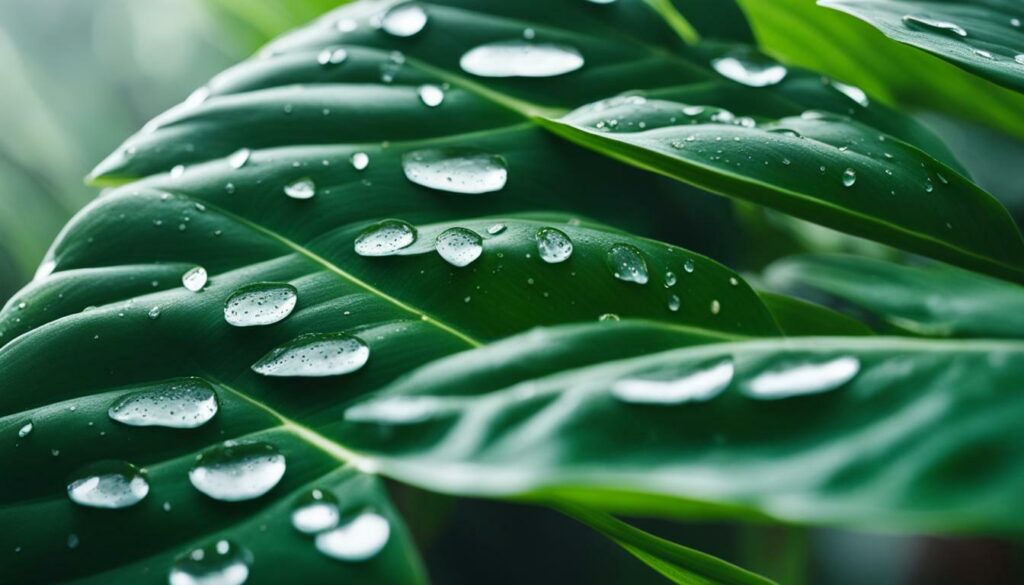
Monstera Borsigiana, like many tropical plants, flourishes in moderate humidity levels. This means that the air around the plant should not be too dry or too moist. Maintaining the correct humidity can prevent issues like leaf yellowing, browning, or curling.
To ensure that your Monstera Borsigiana receives the right amount of humidity, it’s important to monitor and adjust the conditions accordingly. One way to measure humidity is by using a hygrometer, a device that provides accurate readings of the moisture levels in the air. Aim for a humidity range of 40-60% for your Monstera Borsigiana.
In addition to misting, the use of a pebble tray or a humidifier, you can also create a mini greenhouse effect by placing your Monstera Borsigiana in a plastic bag or using a terrarium. These enclosed environments help retain moisture and promote the desired level of humidity.
| Humidity Level | Actions to Take |
|---|---|
| Below 40% |
|
| Above 60% |
|
Remember to regularly assess the humidity levels around your Monstera Borsigiana and make adjustments as needed. With the right amount of humidity, your plant will thrive and display its stunning foliage.
Regular Fertilization for Optimal Growth
Providing regular fertilization is key to ensuring the healthy growth of your Monstera Borsigiana. This tropical plant thrives on nutrient-rich soil and benefits greatly from a balanced fertilizer. By incorporating regular fertilization into your care routine, you can promote lush foliage, vibrant colors, and overall plant vigor.
It is recommended to use a slow-release fertilizer specifically formulated for indoor plants. This type of fertilizer gradually releases nutrients over time, providing a steady supply of essential elements without the risk of over-fertilization. A balanced NPK (nitrogen, phosphorus, and potassium) ratio is ideal for Monstera Borsigiana, ensuring proper growth and development.
When applying fertilizer, it is important to follow the instructions provided by the manufacturer. Over-fertilization can cause nutrient burn and damage the roots, so it is crucial to apply the correct amount. Generally, fertilizing once every 4-6 weeks during the growing season (spring and summer) is sufficient. During the dormant season (fall and winter), you can reduce or suspend fertilization since the plant’s growth slows down.
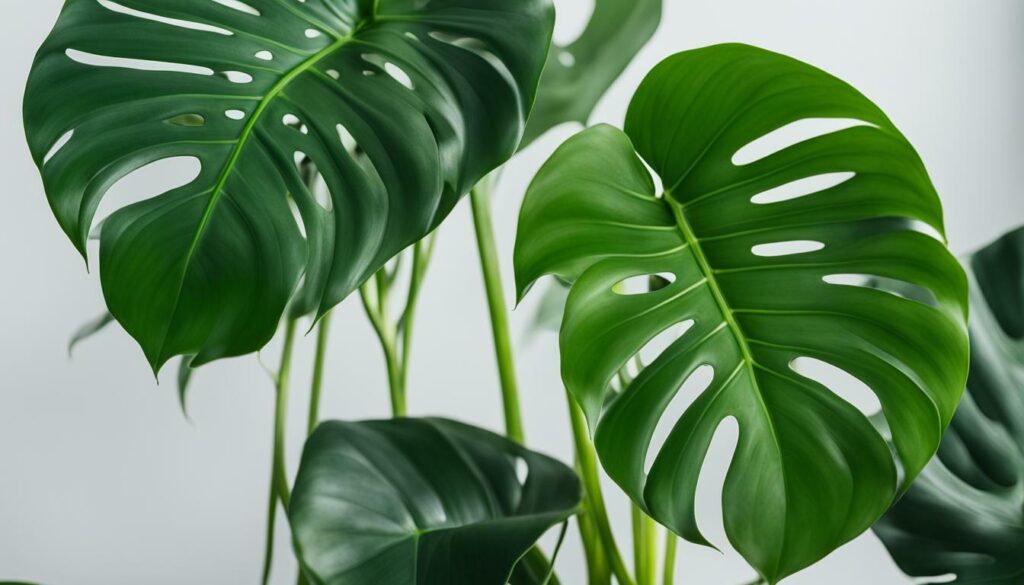
Quote: “Regular fertilization is essential for the optimal growth of Monstera Borsigiana. By providing the necessary nutrients, you can help your plant thrive and maintain its stunning beauty.” – Monstera expert, Jane Doe
Monstera Borsigiana Fertilization Schedule:
| Season | Fertilization Frequency |
|---|---|
| Spring and Summer | Once every 4-6 weeks |
| Fall and Winter | Reduce or suspend fertilization |
Remember to always monitor your Monstera Borsigiana for any signs of nutrient deficiencies or excesses. Yellowing leaves, stunted growth, and pale foliage can indicate a lack of nutrients, while burnt leaf tips or brown, crispy edges may be signs of over-fertilization. Adjust your fertilization routine accordingly to maintain optimal plant health.
Common Issues and Troubleshooting
Despite your best efforts, you may encounter common issues when caring for Monstera Borsigiana, but don’t worry – with a little troubleshooting, you can help your plant thrive. Here are some of the most common problems you may come across and how to address them:
Lack of Leaf Splitting
One of the most distinctive features of Monstera Borsigiana is its beautifully split leaves. If you notice that your plant’s leaves are not splitting as they should, it could be due to insufficient light. Monstera Borsigiana thrives in bright but indirect sunlight, so make sure your plant is receiving enough light. If necessary, move it to a brighter location or consider using artificial plant lights to supplement the natural light.
Overwatering
Overwatering is a common issue that can lead to root rot and other problems. To avoid overwatering, make sure to let the top 2 inches of soil dry out before watering your Monstera Borsigiana. Stick your finger into the soil to check the moisture level – if it feels dry, it’s time to water. Additionally, ensure that your plant’s pot has adequate drainage to prevent water from pooling at the bottom.
Insect Infestation
Monstera Borsigiana is generally a hardy plant, but it can still fall victim to insect infestations. Common pests include spider mites, mealybugs, and aphids. If you notice any signs of pests, such as webbing, tiny white insects, or yellowing leaves, take action immediately. Remove any affected leaves, and treat the plant with a mild insecticidal soap or neem oil spray according to the product instructions.
By being proactive and addressing these common issues promptly, you can ensure that your Monstera Borsigiana remains healthy and vibrant. Remember, every plant is unique, so pay close attention to its specific needs and make adjustments as necessary. With a little care and attention, your Monstera Borsigiana will continue to thrive and bring beauty to your home or office.
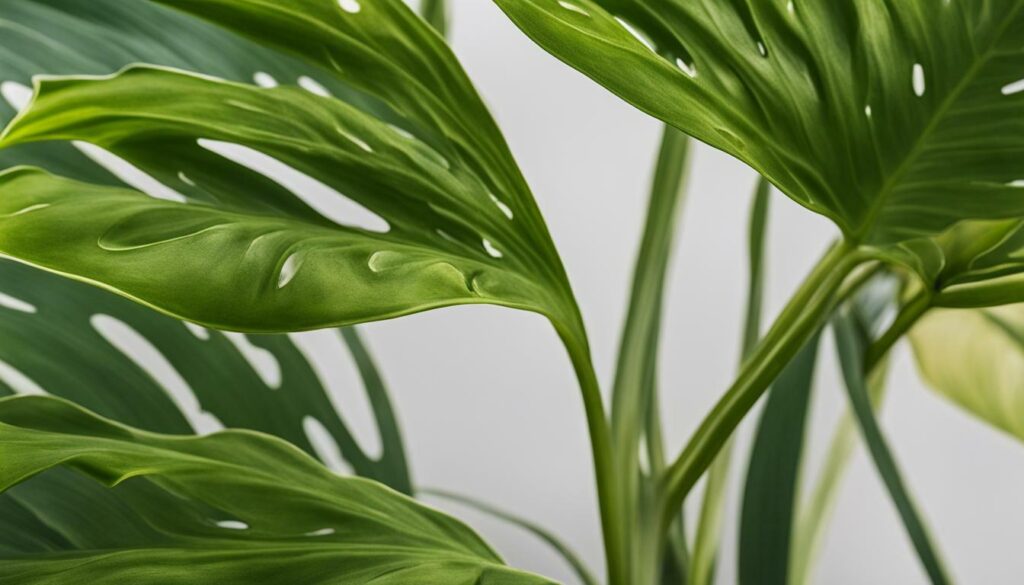
| Problem | Solution |
|---|---|
| Lack of leaf splitting | Ensure adequate bright but indirect sunlight |
| Overwatering | Allow top 2 inches of soil to dry out before watering |
| Insect infestation | Remove affected leaves and treat with insecticidal soap or neem oil |
Other Varieties of Monstera
In addition to Monstera Borsigiana, there are several other exciting varieties of Monstera that you may come across, such as Monstera Deliciosa and the stunning variegated forms of Monstera Borsigiana. Monstera Deliciosa, also known as the Swiss cheese plant, is one of the most popular and recognizable varieties. It features large, glossy leaves with intricate, Swiss cheese-like holes, adding a unique touch to any indoor space. This variety is known for its robust growth and can reach impressive heights, making it a statement piece in any room.
The variegated forms of Monstera Borsigiana, including Monstera Borsigiana Albo Variegata and Monstera Borsigiana Aurea, are highly sought after by plant enthusiasts. These varieties showcase stunning patterns of creamy white or golden yellow variegation on their leaves, creating a striking visual effect. The variegation can vary from plant to plant, making each one truly unique. Due to their rarity and aesthetic appeal, these variegated Monstera varieties are often more expensive and harder to find than the standard green Monstera Borsigiana.
When caring for these other varieties of Monstera, it is important to follow similar guidelines as those for Monstera Borsigiana. Provide them with well-draining soil, bright but indirect sunlight, and regular watering when the top layer of soil is dry. Maintaining a moderate temperature and humidity level is also crucial for their growth and overall health. Just like Monstera Borsigiana, regular fertilization and proper pruning techniques are essential to promote optimal growth and maintain their desired appearance.
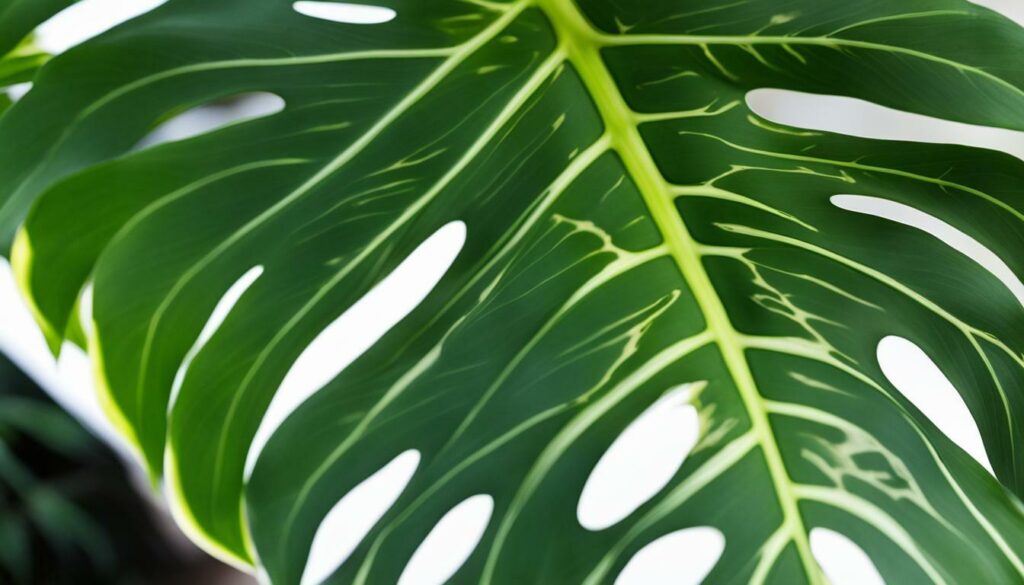
Pruning and Repotting Techniques
Regular pruning and repotting are essential to keep your Monstera Borsigiana in optimum condition and allow it to continue thriving. Pruning helps maintain the plant’s shape, control growth, and remove any dead or diseased foliage. It also encourages new growth and prevents the plant from becoming too leggy.
Start by inspecting your Monstera Borsigiana and identifying any yellowing or damaged leaves. Using clean, sharp pruning shears, make clean cuts just above the node where the leaf meets the stem. This will promote new growth at the nodes and encourage a bushier appearance. If your Monstera Borsigiana is becoming too large for its current pot, it’s time to repot.
Choose a well-draining potting mix suitable for tropical plants. Gently remove the plant from its current pot and carefully separate the roots to avoid damaging them. Place the plant in a slightly larger pot and add fresh soil around the roots, ensuring it is evenly distributed. Avoid planting the Monstera Borsigiana too deep or too shallow. Water the plant thoroughly after repotting to help settle the soil and hydrate the roots.
| Pruning Tips | Repotting Tips |
|---|---|
| Regularly remove dead or yellowing leaves to maintain the plant’s appearance. | Choose a slightly larger pot with drainage holes to allow for proper root growth. |
| Trim any leggy or excessively long stems to encourage bushier growth. | Use a well-draining potting mix to prevent waterlogging and root rot. |
| Prune back any vines that are growing too long or out of control. | Repot every 1-2 years to provide fresh nutrients and space for the plant to grow. |
Expert Tip:
When pruning your Monstera Borsigiana, remember that less is more. Avoid overly aggressive pruning, as this can shock the plant and inhibit its growth. Instead, opt for light pruning regularly to maintain a neat and healthy appearance.
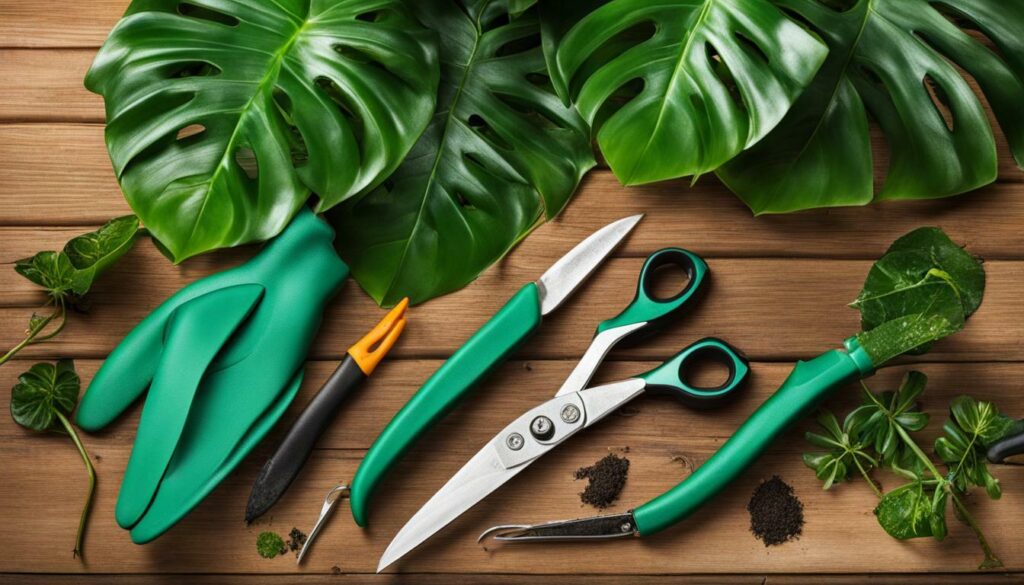
Regularly monitoring and maintaining your Monstera Borsigiana through proper pruning and repotting techniques will help ensure its long-term health and beauty. By following these tips, you can enjoy a thriving and lush Monstera Borsigiana that adds life and greenery to your space.
Conclusion
With the right care and attention, your Monstera Borsigiana can be a stunning addition to your indoor plant collection, bringing a touch of the tropics into your home. By following the maintenance tips and caring guide provided in this article, you can ensure that your Monstera Borsigiana thrives and flourishes.
Remember to use well-draining soil and water your plant when the top 2 inches of soil are dry. Ensure that your Monstera Borsigiana receives bright but indirect sunlight, as this will help it grow and develop properly. Maintaining a moderate temperature and humidity will also contribute to its overall health and well-being.
Fertilization is essential for optimal growth, so be sure to regularly fertilize your Monstera Borsigiana with appropriate fertilizers. This will provide the necessary nutrients for your plant to flourish and produce vibrant foliage.
If you encounter any issues with your Monstera Borsigiana, such as leaves not splitting or insect infestation, refer to the troubleshooting tips discussed in this article. Proper pruning and repotting techniques are also important for maintaining the health and appearance of your Monstera Borsigiana.
Finally, be aware that there are other varieties of Monstera, such as Monstera Deliciosa, Monstera Borsigiana Albo Variegata, and Monstera Borsigiana Aurea, which offer different characteristics and aesthetics for plant enthusiasts.
With a little knowledge and the right care, you can enjoy the beauty and elegance of Monstera Borsigiana in your own home, creating a lush and tropical atmosphere that will be the envy of all who visit.
FAQ
What is Monstera Borsigiana?
Monstera Borsigiana is a variety of monstera plant that is slightly smaller than monstera deliciosa and grows faster. It can be identified by the lack of ruffles or bumps on the stem where it meets the base of the leaf. Monstera Borsigiana is also known for its ability to mutate and display variegation.
Where can I find Monstera Borsigiana?
Monstera Borsigiana can be found in local nurseries, home improvement stores, and online sources.
How should I care for Monstera Borsigiana?
When caring for Monstera Borsigiana, it is important to use well-draining soil, provide bright but indirect sunlight, water when the top 2 inches of soil are dry, maintain a moderate temperature and humidity, and fertilize regularly.
What are common issues that may arise with Monstera Borsigiana?
Common issues that may arise include leaves not splitting, lack of light, overwatering, and insect infestation.
Are there other varieties of Monstera?
Yes, other varieties of Monstera include Monstera Deliciosa, Monstera Borsigiana Albo Variegata, and Monstera Borsigiana Aurea.
How do I prune and repot Monstera Borsigiana?
Proper pruning and repotting techniques are important for maintaining Monstera Borsigiana. Consult a care guide or seek advice from a professional for best practices.
